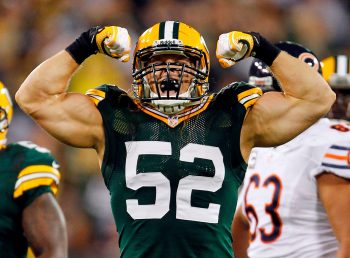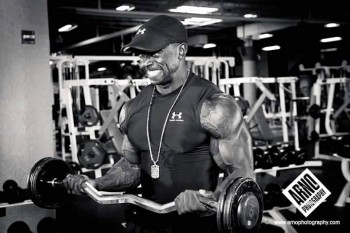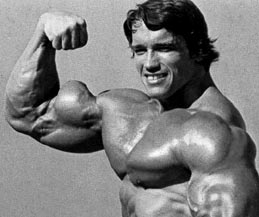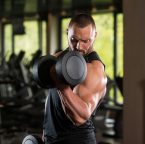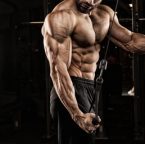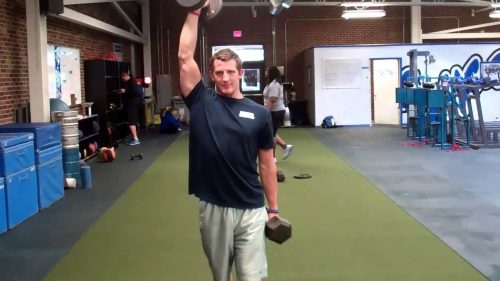Ok, you are looking to build some serious biceps but all you have is a couple of dumbbells.
Or maybe you just don’t like using barbells, even the cambered ones.
Whatever the reason, want to grow your biceps using only dumbbells. If that’s the case, you have come to the right place.
In this post, we are going to give you the 15 best biceps exercises you can do with just a set of dumbbells.
So sit back, relax, and let’s get this party started.
#1 Standing Dumbbell Biceps Curls
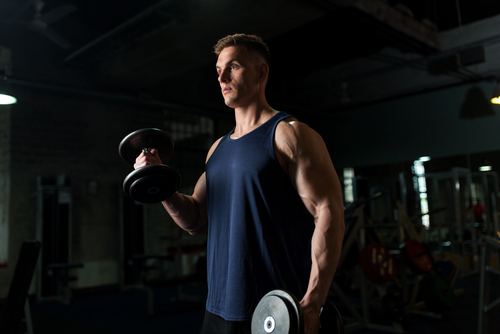
This is probably the most common biceps exercise out there. Any gym you go to you will see some dude standing in front of the rack of dumbbells curling away.
Standing biceps curls are a classic move for good reason, they are one of the best dumbbell bicep exercises out there. Here’s what they’re all about:
When you’re looking to target those biceps in a straightforward yet effective way, standing biceps curls with dumbbells might be your go-to exercise. It’s a fundamental movement that’s often included in many workout routines, and it’s pretty easy to get the hang of.
Here’s how you do standing biceps curls:
- Grab a pair of dumbbells and stand up straight with your feet shoulder-width apart, holding the dumbbells with your palms facing forward.
- Keeping your elbows close to your body, curl the dumbbells up towards your shoulders.
- Pause for a moment at the top to really feel that bicep squeeze, then slowly lower the dumbbells back down.
- Aim for about 3-4 sets of 8-15 reps.
You can do these curls either one arm at a time or both together. This exercise can be a foundational part of your arm workout, and it’s versatile enough to fit into many different training programs. Keep an eye on your form, make sure to control the weight, and enjoy the satisfying work on those biceps.
#2 Dumbbell Hammer Curl
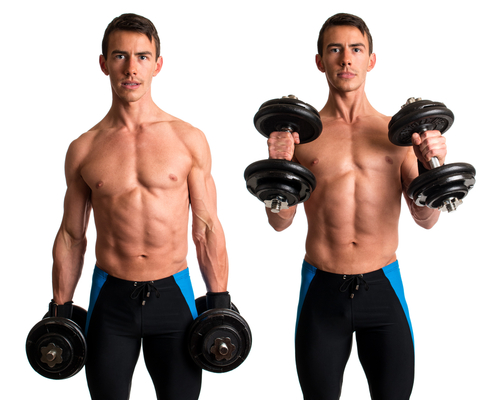
Hammer curls are another great way to work the biceps and they also work the brachialis to make your arms bigger, and they also engage the muscles in the forearms. Here’s a friendly rundown:
When you’re looking to add a little variety to your bicep routine and want to bring those forearms into play, dumbbell hammer curls are the way to go. This exercise is similar to the traditional bicep curl, but with a different grip, giving you a unique challenge.
Here’s how to do hammer curls:
1. Grab a pair of dumbbells, and stand up straight with your feet shoulder-width apart. Hold the dumbbells with your palms facing each other.
2. Keep your upper arms stationary, and curl the dumbbells upward towards your shoulders, maintaining that grip.
3. Pause for a moment at the top, feeling the bicep and forearm engagement, and then slowly return to the starting position.
4. Shoot for 3-4 sets of 8-15 reps.
You can perform these curls either one arm at a time or both together. Hammer curls are an excellent addition to your arm training regimen, adding a fresh angle to your workout. Keep your form solid and focus on the movement, and you’ll be sure to feel the burn in both your biceps muscles and forearms.
#3 Seated Incline Dumbbell Curls
Seated incline biceps curls are a fantastic exercise to isolate the biceps and can really help in building that sought-after biceps peak. Here’s a closer look at how to perform this exercise:
When you want to put some extra emphasis on sculpting a nice bicep peak, seated incline biceps curls might be just the ticket. By using an incline bench, you change the angle of the exercise, which can hit the biceps muscles in a different way and help accentuate that peak.
Here’s how to do seated incline biceps curls:
- Set an incline bench to about a 45-degree angle, and sit back with a dumbbell in each hand, arms fully extended, palms facing forward.
- Keeping your upper arms still, curl the dumbbells upward towards your shoulders.
- Squeeze those biceps at the top and appreciate that peak contraction, then slowly lower the weights back down.
- Aim for 3-4 sets of 8-15 reps.
You can perform these curls one arm at a time or simultaneously. The inclined position might make these curls feel a bit more challenging, but it’s that unique angle that really helps target the muscles for a nice bicep peak. Focus on the movement, control the weight, and enjoy this fresh take on a classic bicep exercise.
#4 Preacher Curls with Dumbbells
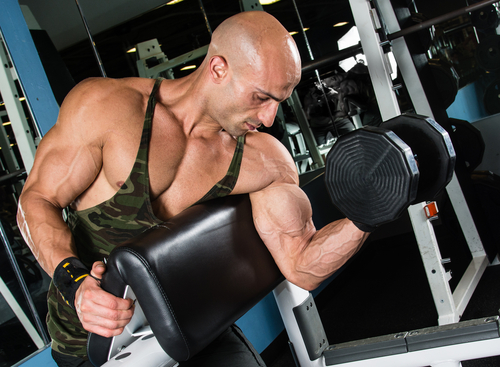
Dumbbell preacher curls are another great exercise that not only isolates the biceps but can also contribute to building that desirable bicep peak. Here’s how to incorporate them into your routine:
When you want to really zero in on those biceps muscles and add some definition to that peak, dumbbell preacher curls can be a great choice. By using a preacher bench, you stabilize the arms, targeting the bicep muscles in a unique way.
Here’s how to do dumbbell preacher curls:
- Sit at a preacher bench and grasp a dumbbell in one hand with an underhand grip.
- Place the back of your upper arm on the preacher pad, arm fully extended, and the other hand can rest on the top of the bench or on your leg.
- Curl the dumbbell upwards towards your shoulder, keeping the back of your upper arm against the pad.
- Feel the squeeze at the top, emphasizing that bicep peak, then slowly lower the weight back down.
- Complete 3-4 sets of 8-15 reps for each arm.
The support provided by the preacher pad helps to isolate the biceps, preventing other muscles from taking over the movement. This can lead to a more focused and intense bicep workout, helping you to sculpt that nice peak. Maintain control and really focus on the biceps as you perform this exercise for the best results.
#5 Concentration Curls
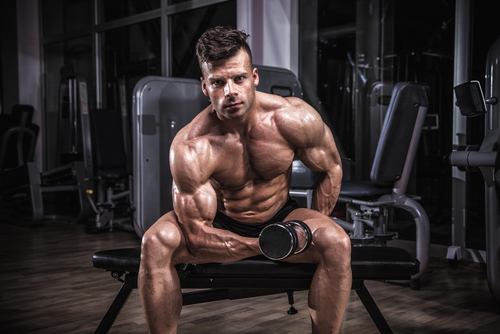
Concentration curls are a fantastic isolation exercise to add to your dumbbell biceps workout that really puts the spotlight on the biceps. They’re well-suited for emphasizing the bicep peak and allowing for targeted muscle engagement. They were also a favorite of Arnold and we all know he had a pretty sick peak. Here’s a guide to performing this exercise:
If you’re looking to hone in on those biceps muscles and work towards a more pronounced peak, concentration curls are a stellar choice. The positioning of this exercise helps you to eliminate momentum and really focus on the bicep.
Here’s how to do concentration curls:
- Sit on a bench with your feet flat on the floor and a dumbbell in one hand.
- Lean slightly forward, and place the back of your upper arm against your inner thigh.
- Starting with the arm fully extended, curl the dumbbell upward towards your chest, keeping the upper arm stationary.
- Hold that contraction at the top, feeling the bicep work, then slowly lower back to the starting position.
- Perform 3-4 sets of 8-15 reps on each arm.
The seated and braced position of concentration curls helps to isolate the bicep muscle, allowing you to really zero in on it. By focusing on the contraction and controlling the movement, you’ll be working effectively towards building that nice bicep peak. Concentration curls are an excellent addition to your arm workout routine, providing a unique angle to target the biceps.
#6 Seated Alternating Dumbbell Curl
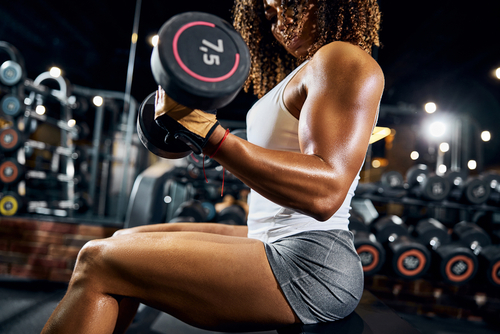
Seated dumbbell curls are a popular bicep exercise that can add variety to your arm training routine. The seated position provides a different feel compared to the standing version, leading to a unique muscle engagement. Here’s an overview of how to do this exercise:
When you’re in the mood for a change from standing bicep curls, taking a seat might be just what you need. The dumbbell supinated biceps curl offers a different feel, as sitting down helps stabilize your body, making it a bit more challenging to use momentum. This can lead to more focused work on the biceps.
Here’s how to do seated dumbbell curls:
- Sit on a bench with your feet flat on the floor and a dumbbell in each hand, arms fully extended, palms facing forward.
- Keeping your upper arms stationary, curl the dumbbells upwards towards your shoulders.
- Savor the squeeze at the top, then slowly lower the weights back down.
- Aim for 3-4 sets of 8-15 reps.
You can perform these curls either one arm at a time or both together. The seated position changes the dynamics of the exercise, making it feel different from the standing version. This variation can help you target the biceps from a new angle and adds diversity to your arm training regimen. Emphasizing control and focusing on the biceps muscle as you perform this exercise can lead to effective muscle building and toning. Enjoy the seated change of pace
#7 Cross-Body Hammer Curl
Cross-Body Hammer Curls are an engaging variation of the traditional dumbbell hammer curl, emphasizing not just the biceps but also the forearms and even the brachialis. The cross-body motion offers a unique feel and targets the muscles in a slightly different way. Here’s a rundown of how to perform this exercise:
Looking for a twist on the traditional hammer curl that adds a fresh angle to your arm routine? Cross-Body Hammer Curls are worth a shot. By curling the dumbbell across your body towards the opposite shoulder, you engage the muscles differently, giving your arms a unique challenge.
Here’s how to do Cross-Body Hammer Curls:
- Stand up straight, holding a dumbbell in each hand with your palms facing your torso.
- Keeping your upper arms stationary, curl one dumbbell towards the opposite shoulder, maintaining the hammer grip.
- Feel the squeeze across your arm, then slowly lower the weight back down.
- Alternate arms, and aim for 3-4 sets of 8-15 reps for each arm.
The cross-body motion adds an extra dimension to the traditional hammer curl, providing a different feel and emphasizing the muscles in a new way. This exercise can be a valuable addition to your arm training routine, offering variety and a unique approach to targeting the biceps, brachialis, and forearms. Focus on control and enjoy the different sensation that Cross-Body Hammer Curls bring to your workout.
#8 Zottman Curl
Certainly! The Zottman Curl is an exciting variation that combines elements of standard curls and reverse curls, targeting the biceps, brachialis, and forearms. This unique twist adds variety to your workout and challenges different muscle groups within the same movement. Here’s how you can perform the Zottman Curl:
Want to spice up your arm routine with a curl that hits several muscle groups at once? Give the Zottman Curl a try. By alternating the grip during the movement, you engage both the biceps on the way up and the forearms on the way down.
Here’s how to do Zottman Curls:
1. Stand up straight, holding a dumbbell in each hand with your palms facing forward.
2. Curl the dumbbells towards your shoulders, just like a regular bicep curl.
3. At the top of the curl, rotate your wrists so your palms are now facing downward.
4. Slowly lower the dumbbells with this reverse grip, engaging your forearms.
5. Rotate your wrists back to the starting position, and repeat.
6. Aim for 3-4 sets of 8-15 reps.
The Zottman Curl is a versatile exercise that offers a unique combination of bicep and forearm work. This curl adds a dynamic twist to your arm training regimen and can be a fun and effective way to challenge different parts of the arm within a single exercise. Focus on the wrist rotation and control the movement to get the most out of this creative curl variation,
#9 Dumbbell Reverse Biceps Curls
Reverse curls are a unique exercise that targets not only the biceps but also the brachialis and forearms. By utilizing an overhand grip, this variation provides a different challenge compared to traditional bicep curls. Here’s what you need to know about reverse curls:
Looking to mix things up in your arm training? Reverse curls can be a refreshing change of pace. With an overhand grip, this exercise places a different kind of strain on the biceps, and the forearms get to join the party as well.
Here’s how to do reverse curls:
- Stand up straight, holding a pair of dumbbells with an overhand grip (palms facing down).
- Keeping your upper arms stationary, curl the dumbbells upward, working against the resistance created by the grip.
- Pause for a moment at the top, feeling the engagement in the biceps and forearms, then slowly lower the weights back down.
- Perform 3-4 sets of 8-15 reps.
The reverse grip adds a different feel to the standard bicep curl and can provide a unique challenge. By focusing on control and maintaining the overhand grip throughout the movement, reverse curls can be an excellent way to target the biceps muscles, brachialis, and forearms from a new angle. Incorporate this exercise into your routine to add variety and hit those arm muscles in a refreshing way.
#10 Spider Curls
Spider curls are a specialized bicep exercise that allows for a greater range of motion and intense focus on the biceps. By utilizing an inclined bench, you can achieve a stretch in the biceps that’s hard to replicate with other exercises. Here’s a closer look at spider curls:
Interested in an exercise that zeroes in on the biceps and provides a unique stretch? Spider curls might be just what you’re looking for. By leaning over an inclined bench, you isolate the biceps and create a different angle that can lead to deep muscle engagement.
Here’s how to do spider curls:
- Set an incline bench to about a 45-degree angle and lie face down, so your chest is pressing against the bench, and your arms are hanging straight down.
- Hold a dumbbell in each hand with an underhand grip, palms facing up.
- Keeping your upper arms stationary, curl the dumbbells towards your shoulders.
- Savor the contraction at the top, feeling the biceps working, then slowly lower back to the starting position.
- Perform 3-4 sets of 8-15 reps.
The positioning in spider curls helps to isolate the biceps and restrict other muscles from taking over, offering a unique feel and a focused challenge. The stretch at the bottom of each rep adds an extra dimension to this exercise, making it a valuable addition to your arm training regimen. Focus on maintaining control and feeling the muscles work as you perform this engaging curl variation!
#11 21s (Bicep Curl 21s)
Bicep Curl 21s are a unique and challenging bicep exercise that breaks down the curl into three distinct ranges of motion. This approach keeps the muscles under tension for an extended period, leading to intense muscle engagement. Here’s how you can incorporate 21s into your arm routine:
Looking to really push those biceps to the limit? 21s could be the answer. This exercise divides the curl into three segments, with 7 repetitions in each, creating a total of 21 reps that keep the biceps under continuous tension.
Here’s how to do Bicep Curl 21s:
- Stand up straight, holding a dumbbell in each hand with an underhand grip.
- Start by performing 7 half-curls from the bottom to the midpoint (elbows at 90 degrees).
- Next, perform 7 half-curls from the midpoint to the top, fully contracting the biceps.
- Finish with 7 full curls, moving through the entire range of motion from bottom to top.
- Repeat for 3-4 sets.
21s provide a different feel compared to traditional bicep curls by emphasizing different parts of the curling motion. This can lead to deeper muscle engagement and a more challenging workout. The segmented approach keeps the muscles guessing and adds a fun and intense twist to your bicep training. Emphasize control and smooth transitions between the segments to get the most out of this creative exercise.
#12 Close Grip Dumbbell Curls
Here’s the revised version specifically focusing on Close Grip Dumbbell Curls:
Are you on the lookout for a bicep exercise that offers a unique twist on a classic curl? Close Grip Dumbbell Curls might be what you’re looking for. By bringing your hands closer together while performing a curl, you emphasize different parts of the biceps and add a new challenge to your routine.
Here’s how to do Close Grip Dumbbell Curls:
- Stand up straight, holding a dumbbell in each hand, palms facing forward, and hands close together.
- Keep your elbows tight to your body to maintain proper alignment.
- Curl the dumbbells towards your shoulders, focusing on the outer part of the biceps doing the work.
- Pause at the top of the movement, then slowly lower the weights back to the starting position.
- Perform 3-4 sets of 8-15 reps.
Close Grip Dumbbell Curls are especially valuable for those who want to hit the biceps from a slightly different angle. By adjusting the grip, you ensure that the movement feels fresh and that the focus shifts to different muscle fibers within the biceps. This exercise can be a useful tool to diversify your bicep training and sculpt your arms in a novel way. Emphasize the mind-muscle connection, and explore the benefits of this targeted curl variation!
Related: 13 Best Exercises for Big Biceps Ranked: Growth and Mass
Related: 10 Best Exercises For Building Massive Triceps
Related: Compound Exercises That Build Bigger Arms
#13 Step Back Biceps Curl
The Step Back Biceps Curl is a dynamic exercise that combines a traditional bicep curl with a step-back movement, engaging not only the arms but also the legs and core. This compound exercise offers a different feel and provides a more full-body experience. Here’s how to perform the Step Back Biceps Curl:
Looking for a bicep exercise that brings more of your body into play? The Step Back Biceps Curl might be just what you need. By adding a step-back motion to the traditional curl, you engage the legs and core, making it a more comprehensive workout.
Here’s how to do Step Back Biceps Curls:
- Stand up straight, holding a dumbbell in each hand with palms facing forward.
- As you begin to curl the dumbbells towards your shoulders, simultaneously step one foot back into a lunge position.
- Pause in the lunge with the dumbbells at shoulder height, then push off the back foot to return to the starting position, lowering the dumbbells.
- Repeat on the other side, alternating legs, for 3-4 sets of 8-15 reps per side.
The Step Back Biceps Curl adds an exciting twist to the traditional bicep curl, engaging more muscles and offering a different challenge. This exercise can be a great way to add some variety to your routine, working both the upper and lower body at the same time. Focus on maintaining balance and control during the movement, and enjoy the extra dimension that the step-back adds to your arm training
#14 Dumbbell Wall Biceps Curl
The Dumbbell Wall Biceps Curl is a strategic variation that uses a wall to help isolate the biceps and minimize the involvement of other muscles. By leaning against a wall, you can focus more intently on the biceps and ensure that the movement is controlled and precise. Here’s an overview of how to perform the Dumbbell Wall Biceps Curl:
Are you interested in a bicep exercise that promotes proper form and isolates the muscle? The Dumbbell Wall Biceps Curl could be your answer. By using a wall to stabilize the body, you can eliminate momentum and really hone in on the biceps.
Here’s how to do Dumbbell Wall Biceps Curls:
- Stand up straight with your back against a wall, holding a dumbbell in each hand, palms facing forward.
- Keep your shoulders, elbows, and back in contact with the wall to maintain alignment.
- Curl the dumbbells towards your shoulders, focusing on the biceps doing the work.
- Pause at the top of the movement, then slowly lower the weights back to the starting position.
- Perform 3-4 sets of 8-15 reps.
The Dumbbell Wall Biceps Curl is particularly valuable for those who want to concentrate on the biceps without other muscles intervening. The wall acts as a guide, ensuring that the movement stays strict and that the focus remains on the biceps. This exercise can be a useful tool to reinforce proper form and build strength in a controlled manner. Emphasize the mind-muscle connection and enjoy the benefits of this targeted curl variation.
#15 Fat Grip Dumbbell Curls
Fat Grip Dumbbell Curls are a unique variation of the traditional dumbbell curl that involves using a thicker grip. This change in grip size challenges the forearms and grip strength in addition to the biceps. Here’s a closer look at Fat Grip Dumbbell Curls:
Interested in adding a new layer of difficulty to your bicep curls? Fat Grip Dumbbell Curls might be what you’re looking for. By increasing the diameter of the grip, you engage the forearms more and make the whole exercise more demanding on the hands and arms.
Here’s how to do Fat Grip Dumbbell Curls:
- Attach fat grips to your dumbbells or use specially designed fat grip dumbbells.
- Stand up straight, holding the dumbbells with your palms facing forward.
- Curl the dumbbells towards your shoulders, keeping your upper arms stationary.
- Feel the engagement not just in the biceps, but also in the forearms due to the thicker grip.
- Slowly lower the weights back to the starting position.
- Perform 3-4 sets of 8-15 reps.
Fat Grip Dumbbell Curls provide a different feel and challenge compared to standard bicep curls. The increased grip diameter forces your forearms and grip to work harder, adding an extra dimension to the exercise. This can lead to improved grip strength and a more comprehensive arm workout. If you’re looking to mix things up and push your arms in a new way, give this variation a try! Focus on maintaining control with the thicker grip, and enjoy the unique benefits of this creative curl variation.
Biceps Anatomy and Function
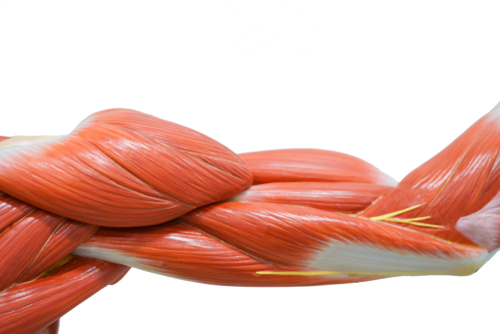
Let’s take a more casual and human-like approach to understanding the biceps, their structure, and what they do for us every day.
Biceps Anatomy: What’s Going On There?
When we talk about the “biceps,” we’re usually thinking about that muscle that pops up when you flex your arm. But there’s a bit more to it. The biceps brachii has two parts, or “heads”:
- Long Head: This one starts up near the shoulder and is the part you see from the side view.
- Short Head: This one’s closer to the inside of your arm, and you can see it more from the front.
Both of these heads come together and attach near the elbow, working together to make your arm move.
So, What Do the Biceps Actually Do?
Your biceps aren’t just there to look good; they have some important jobs:
- Bending Your Arm: When you pick up your coffee or bring food to your mouth, that’s your biceps at work.
- Turning Your Palm Up: Want to check your nails or receive a handout? Your biceps help with that rotating motion.
- Lifting Your Arm Forward: Though not their main gig, biceps pitch in when you lift your arm in front of you.
- Keeping Your Shoulder Steady: The top part of your biceps helps your shoulder stay stable, especially when you reach for something overhead.
How Does This Help My Workout?
Knowing what your biceps are up to can help you train them better. For instance:
- Traditional bicep curls are great because they work on that bending and rotating action.
- Using different grips or variations like hammer curls hits different parts of the arm.
- Understanding how the biceps work can help you pick exercises that suit your goals, whether you’re looking to get stronger or just have more toned arms.
So next time you’re in the gym, you’ll know that those biceps aren’t just for show. They’re hardworking muscles that help you with everyday tasks, and understanding them a bit better might even give you a fresh perspective on your workout routine.
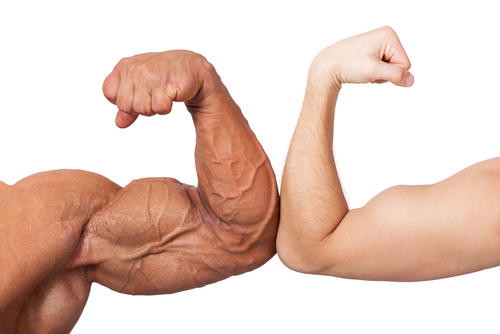
Using Progressive Overload To Build Bigger Biceps
Now that you have the exercises you need, let’s grow those guns with progressive overload!
Progressive overload sounds like a fancy term, but it’s really just about challenging your muscles gradually to get them to grow. If you’re looking to build bigger biceps, this concept is your friend. Let’s break it down in plain terms.
What’s Progressive Overload Anyway?
Imagine lifting the same 10-pound dumbbell every time you work out. It’s great at first, but after a while, your muscles get used to it. They’re not really being challenged anymore. Progressive overload is like telling your muscles, “Hey, I know you can do this, but let’s see if you can do a little more!
How to Use Progressive Overload for Bigger Biceps
- Add More Weight: Start with a weight you can lift for your desired number of reps, then gradually increase it as that becomes easier. So if those 20-pound curls feel like a breeze, it might be time to reach for the 25-pounders.
- Do More Reps: If heavier weights feel too intimidating at first, you can also try doing more repetitions with the weight you’re using. If you’ve been doing 8 reps, see if you can push it to 10 or 12.
- Switch It Up: Different exercises, angles, and grips challenge your biceps in new ways. Sometimes changing the routine keeps your muscles guessing and growing.
- Don’t Forget to Rest: Muscles grow when they’re resting, not when you’re lifting. Make sure you give your biceps a break between sessions to let them recover and grow.
- Keep Track: Writing down what you’ve lifted and how many reps you’ve done helps you see your progress. Knowing that you’re lifting more over time is not only satisfying but also tells you that you’re on the right track.
Why It Works
Your biceps are like the rest of us; they need a reason to change. By gradually asking more from them, you’re telling those muscles that they need to get bigger and stronger to keep up with what you’re throwing at them.
A Word of Caution
Like anything, there’s a balance. Progressive overload doesn’t mean pushing yourself to the limit every time. It’s a gradual process, and listening to your body is key. If something doesn’t feel right, it probably isn’t.
In a nutshell, building bigger biceps through progressive overload is about gradual growth, mixing things up, and giving your muscles a reason to change. It’s like leveling up in a game. You wouldn’t jump from level 1 to level 10 overnight, right? Same with your biceps. Slow and steady wins the race, and before you know it, you might just find yourself flexing some impressive guns
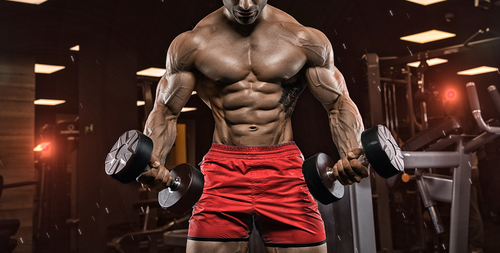
Biceps Training Tips
Building those bicep muscles requires more than just repetitive curling. Here are some valuable tips that focus on specific aspects of bicep training:
- Isolating the Short and Long Head: Your biceps are made up of two main heads: the short head and the long head. Isolating them requires using different angles and grips in your curls. For the short head, try exercises like Preacher Curls. For the long head, exercises like the dumbbell incline biceps curl can be effective.
- Focus on Tension, Not Weight: It’s not always about how heavy you can lift. Creating and maintaining tension in the bicep throughout the movement might be more beneficial for growth. Concentrate on controlling the weight during both the lifting and lowering phases of the exercise.
- Program These After Compound Exercises: Bicep exercises often benefit from being programmed after compound movements like rows or pull-ups. These compound exercises engage the biceps indirectly, pre-fatiguing them so that isolation exercises later can be more effective.
- Use Tempo: The speed at which you perform your curls can impact how your muscles respond. A controlled, slower tempo may increase the time your muscles are under tension, potentially leading to more growth. For example, try a 2-second lift, a 1-second pause at the top, and a 3-second lowering phase.
- Consistent Form: Keeping a consistent and correct form ensures that the focus remains on the biceps. Avoid using momentum or other body parts to assist in the lift.
- Recovery is Key: Your biceps, like all muscles, need time to recover and grow. Ensure you’re giving them enough rest between sessions and nourishing your body with proper nutrition.
- Progressive Overload: Gradually increasing the resistance over time will help in building those biceps. This could mean adding more weight, more reps, or even changing the exercises regularly to prevent plateaus.
By paying attention to these aspects of your bicep training, you’re more likely to see progress and develop those strong, aesthetically pleasing muscles. Remember, understanding the anatomy of your biceps and training them intelligently is the key to those big guns!
Wrap Up
Building biceps that are both strong and visually appealing doesn’t have to mean endless repetitions of the same exercise. By incorporating these 15 dumbbell exercises into your routine, you can engage the muscles from different angles, challenge them in new ways, and break free from workout monotony.
From the classic standing curls to innovative techniques like the Close Grip and Wall Biceps Curls, each exercise offers unique benefits to help you achieve those big guns. Remember to pay attention to form, use progressive overload wisely, and don’t be afraid to mix things up. Your biceps are versatile muscles, and with these diverse exercises, you have everything you need to train them effectively. Happy curling!

Ryan is a former college wrestler and lifelong fitness fanatic. He has run half marathons, done mud runs, placed in body transformation contests, coached wrestling, and now coaches girls’ soccer. Not to mention he has also tried literally hundreds of supplements over the years and has a vast and thorough supplement knowledge. He has written for Muscle & Strength, Testosterone Junkie, The Sport Review and other publications. He is also the editor-in-chief of this website and has over 25 years of experience in the fitness industry. Feel free to connect with him on his LinkedIn page below.

